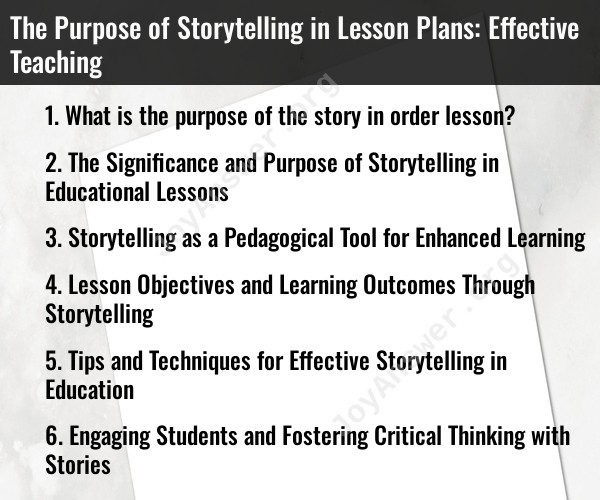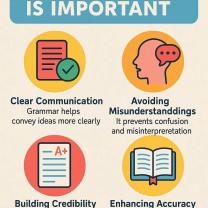What is the purpose of the story in order lesson?
In an educational context, incorporating storytelling into lesson plans serves several important purposes, making teaching more effective and engaging. Here are some key purposes and benefits of using storytelling in lessons:
Capturing Attention and Engagement: Stories have a natural ability to capture students' attention. They create a sense of curiosity and anticipation, which can make students more receptive to the lesson content.
Contextualizing Information: Stories can be used to provide context to the subject matter. They help students see how the topic relates to real-life situations, making it more relatable and understandable.
Enhancing Comprehension: Narratives can simplify complex concepts by breaking them down into relatable scenarios. This can lead to improved comprehension and retention of information.
Emotional Connection: Stories often evoke emotions, and this emotional engagement can enhance the learning experience. Students are more likely to remember and understand a lesson if it stirs their emotions.
Memory Retention: Stories are often easier to remember than dry facts and data. By embedding key information within a story, students are more likely to retain and recall the content.
Critical Thinking and Problem-Solving: Stories can present dilemmas or challenges that require critical thinking and problem-solving skills. This encourages active participation and analytical thinking.
Cultural and Social Awareness: Stories from different cultures and perspectives can promote cultural and social awareness. They expose students to diverse viewpoints and experiences.
Fostering Creativity: Encountering stories can inspire creativity in students. They may be encouraged to create their own stories, art, or projects related to the lesson.
Language Development: Stories enhance language skills. They introduce students to new vocabulary, sentence structures, and communication styles.
Building a Learning Community: Sharing stories can create a sense of community within the classroom. It encourages students to share their own experiences and thoughts, fostering a collaborative learning environment.
Moral and Ethical Lessons: Many stories contain moral or ethical lessons. Analyzing these lessons can contribute to character development and values education.
Engaging Different Learning Styles: Storytelling appeals to various learning styles. Visual learners may benefit from illustrations, auditory learners from spoken narratives, and kinesthetic learners from interactive storytelling.
Long-Term Impact: Stories can leave a lasting impact on students, shaping their attitudes, beliefs, and understanding of the world. They often remember the stories they hear long after the lesson is over.
It's important to note that the effectiveness of storytelling in education depends on how well it's integrated into the curriculum, the relevance of the story to the lesson, and the teacher's ability to guide discussions and activities based on the story. Storytelling should be used thoughtfully and strategically to support the specific learning objectives of a lesson.
The Significance and Purpose of Storytelling in Educational Lessons
Storytelling is a powerful teaching tool that has been used for centuries to engage students, promote learning, and convey important messages. Stories can help students to:
- Understand complex concepts: Stories can make abstract concepts more concrete and relatable for students.
- Develop critical thinking skills: Stories can challenge students to think critically about the characters, plot, and themes of the story.
- Develop empathy and compassion: Stories can help students to understand and empathize with others from different backgrounds and perspectives.
- Increase motivation and engagement: Stories can make learning more fun and engaging for students.
- Promote creativity and imagination: Stories can spark students' imaginations and encourage them to think creatively.
Storytelling as a Pedagogical Tool for Enhanced Learning
Storytelling can be used as a pedagogical tool to enhance learning in a variety of ways. For example, teachers can use stories to:
- Introduce new concepts: Stories can be used to introduce new concepts to students in a way that is both engaging and informative.
- Illustrate complex ideas: Stories can be used to illustrate complex ideas in a way that is easy for students to understand.
- Provide real-world examples: Stories can be used to provide students with real-world examples of the concepts they are learning.
- Model critical thinking skills: Stories can be used to model critical thinking skills for students, such as how to analyze characters, plot, and themes.
- Promote discussion and collaboration: Stories can be used to promote discussion and collaboration among students.
Lesson Objectives and Learning Outcomes Through Storytelling
When using storytelling in the classroom, it is important to have clear lesson objectives and learning outcomes in mind. This will help you to ensure that your storytelling activities are aligned with your curriculum and that students are achieving the desired learning outcomes.
Here are some examples of lesson objectives and learning outcomes that can be achieved through storytelling:
- Students will be able to identify and analyze the main elements of a story, such as characters, plot, setting, and theme.
- Students will be able to draw inferences and make predictions about the events of a story.
- Students will be able to compare and contrast different stories.
- Students will be able to use storytelling to communicate their own ideas and experiences.
- Students will be able to develop empathy and compassion for others through storytelling.
Tips and Techniques for Effective Storytelling in Education
Here are some tips and techniques for effective storytelling in education:
- Choose stories that are relevant to your students' interests and experiences.
- Be prepared and practice your storytelling before delivering it to your students.
- Use your voice, facial expressions, and gestures to engage your students.
- Encourage your students to interact with the story by asking questions and participating in activities.
- Relate the story to the concepts you are teaching.
- Follow up the story with a discussion or activity to help students process what they have learned.
Engaging Students and Fostering Critical Thinking with Stories
There are a number of ways to engage students and foster critical thinking with stories. Here are a few ideas:
- Ask students questions about the story: This will help them to think critically about the characters, plot, and themes of the story.
- Have students write or draw about the story: This will help them to process what they have learned and to express their own thoughts and feelings about the story.
- Have students perform the story: This is a great way for students to engage with the story and to learn about different aspects of storytelling, such as character development, dialogue, and setting.
- Have students create their own stories: This is a great way for students to be creative and to express their own ideas and experiences.
By using storytelling effectively in the classroom, teachers can create engaging and meaningful learning experiences for their students.













